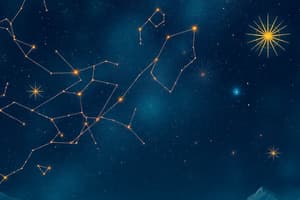Podcast
Questions and Answers
How were constellations originally defined?
How were constellations originally defined?
Constellations were originally defined based upon the shapes of stars.
How are constellations defined today?
How are constellations defined today?
They are now defined based upon groupings of stars.
How does the appearance of the sky change during the evening or during the year?
How does the appearance of the sky change during the evening or during the year?
The appearance of the night sky changes so that the stars rotate around the polar star once every 2 hours.
How many hours changes the appearance of the sky on one day to match the sky at the same time of day a month later?
How many hours changes the appearance of the sky on one day to match the sky at the same time of day a month later?
What is the ecliptic?
What is the ecliptic?
How was the location of the ecliptic determined?
How was the location of the ecliptic determined?
What is special about the signs of the Zodiac?
What is special about the signs of the Zodiac?
What aspect of planetary motion is hard to model?
What aspect of planetary motion is hard to model?
What ancient Greek mathematician developed an early model of planetary motion?
What ancient Greek mathematician developed an early model of planetary motion?
What was Aristotle's view of the heavens like?
What was Aristotle's view of the heavens like?
What determined the order of the spheres according to Aristotle?
What determined the order of the spheres according to Aristotle?
How did Eratosthenes measure the circumference of the earth?
How did Eratosthenes measure the circumference of the earth?
What contribution to early astronomy was made by Hipparchus?
What contribution to early astronomy was made by Hipparchus?
Who used Hipparchus's data to make a model of the solar system?
Who used Hipparchus's data to make a model of the solar system?
Who developed the first 'workable' model of the solar system?
Who developed the first 'workable' model of the solar system?
Who was the first proponent of the heliocentric universe?
Who was the first proponent of the heliocentric universe?
Who was the modern day proponent of the heliocentric universe?
Who was the modern day proponent of the heliocentric universe?
Who won the 'Battle for the Heavens' in the hearts and minds of the common people?
Who won the 'Battle for the Heavens' in the hearts and minds of the common people?
What three things made the heliocentric view seem unlikely?
What three things made the heliocentric view seem unlikely?
Why would we say that Ptolemy's model was both accurate and fundamentally incorrect?
Why would we say that Ptolemy's model was both accurate and fundamentally incorrect?
How did Ptolemy's model account for retrograde motion?
How did Ptolemy's model account for retrograde motion?
Why was it ironic that Galileo was threatened with torture for disagreeing with Ptolemy's view?
Why was it ironic that Galileo was threatened with torture for disagreeing with Ptolemy's view?
What is the origin of the modern use of the word 'revolution'?
What is the origin of the modern use of the word 'revolution'?
Flashcards are hidden until you start studying
Study Notes
Constellations and the Night Sky
- Originally, constellations were defined by the shapes made by stars; now they refer to groupings of stars.
- The night sky's appearance rotates around the polar star every 2 hours, with stars shifting one-twelfth of a day or two hours every month.
Ecliptic and Zodiac
- The ecliptic is the moon's location relative to Earth during an eclipse, determined by moon observations.
- Zodiac signs are dictated by which constellation is behind the sun during a particular month.
Planetary Motion
- Retrograde motion, the westward movement of some planets relative to fixed stars, complicates modeling of planetary motion.
- Pythagoras developed an early planetary motion model.
Historical Views of the Cosmos
- Aristotle proposed a geocentric model, positioning Earth at the center with planets ordered by travel speed.
- Eratosthenes calculated Earth's circumference using the distance between Alexandria and Syene along with solar angle measurements.
- Hipparchus made early solar system measurements that Ptolemy later used to develop his model.
Heliocentric vs. Geocentric Models
- Ptolemy's "workable" solar system model was geocentric but acknowledged accurate planetary positions.
- Copernicus introduced the heliocentric model; Galileo championed it in modern times.
- Galileo won public support for heliocentrism despite facing threats from the Church, which favored Aristotle's geocentric beliefs.
Challenges to Heliocentrism
- Heliocentric views were initially dismissed due to:
- Conflicts with common sense.
- Strong acceptance of Aristotle’s geocentrism.
- Lack of observable parallax movement of stars.
Ptolemy's Model
- Ptolemy’s model incorporated retrograde motion through the concept of epicycles, where planets would loop in their orbits.
Cultural and Linguistic Impact
- Galileo's conflict with Ptolemy was ironic due to the Church's adherence to polytheistic beliefs.
- The term "revolution" in its modern sense originates from Copernicus' work, reflecting radical ideas about planetary revolutions around the sun.
Studying That Suits You
Use AI to generate personalized quizzes and flashcards to suit your learning preferences.




